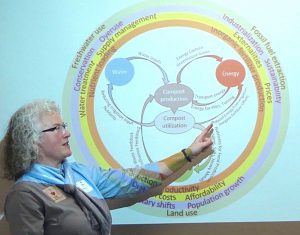University of Vermont faculty members convened a group to identify research needs related to mandatory food scraps diversion policies in New England.
Craig Coker
BioCycle September 2016
Organics, including food scraps and yard trimmings, make up the single largest segment, or 28 percent, of Vermont’s residential solid waste stream. By 2020, all Vermonters will be required by Act 148, the Universal Recycling Law, to divert food scraps and other organics from the landfill. And all haulers and solid waste management facilities will be required to provide services (collection, processing) for these materials.
The Universal Recycling law became effective July 1, 2012, however the food diversion component began to take effect July 1, 2014, requiring diversion for generators of more than 104 tons/year that are within 20 miles of a certified facility. This diversion requirement threshold reduces incrementally each July 1 until 2020 when all food scraps (or residuals) must be diverted. While Vermont’s Agency of Natural Resources (ANR) is responsible for overseeing statewide implementation of the recycling law, municipalities are responsible for the management and regulation of the storage, collection, processing and disposal of solid wastes within their jurisdiction.
Identifying Research Needs
To assess the impacts of mandatory food scraps diversion, Deborah Neher and Jason Parker of the University of Vermont (UVM) were awarded a planning grant from the Northeastern Regional Association of State Agricultural Experiment Station Directors entitled “Regional assessment of the quality control, food safety, environmental, user perception and marketing outlets of diverting food scraps from landfills” in Spring 2015. Neher, a soil ecologist and Chair of UVM’s Plant and Soil Science Department, and Parker, a Research Assistant Professor, gathered a multistate and multidisciplinary team of research and extension faculty in the Northeast who all have an interest in understanding impacts of diverting food scraps from landfills on multiple social, economic and environmental dimensions.
“Passage of the Universal Recycling Law in Vermont brought the topic of diverting food waste from landfills to the forefront,” explains Neher, whose own research has been focusing on compost biology and biological indicators of compost maturity. “The topic raises many research questions that are interdisciplinary in nature. The planning grant offered some funding to pay for folks across the region to meet, brainstorm ideas, and construct proposals.”
The team identified themes to help formulate an agenda as potential funding for research and implementation becomes available. The research themes and potential research topics include the following:
Quality control impacts: Balancing nitrogen sources between abundant manure sources and seasonally variable food scrap composition; Matching product quality and consistency with appropriate end uses.
Food safety risks: Consistency in C:N ratio and liquid composition of food scraps for meeting thermophilic requirements to control plant and animal diseases and parasites.
Environmental risks: Relative direct and indirect contribution of animal manures; Addition of greenhouse gas emissions, e.g., CO2, NOx; Nutrient retention and loss; Invasive species.
Socio economic analysis: Competition for carbon from other waste streams, e.g., compost versus direct burning as renewable energy; Acceptable levels of contaminants; Efficiency and ease of adopting composting processes across geographic scales, e.g., smaller decentralized, larger centralized; Estimate jobs and income generation of composting industry using input-output modeling.
End user requirements, acceptance and markets: Consistent quality materials for food production and landscaping; Quality compost-based products that meet state specs for erosion and storm water control on construction and highway projects, and suitable for use on farms.
Large grant funding for foundational research: Evaluating topics such as composts for suppression of specific plant diseases, integrated composting methods using livestock manure to reduce food safety and animal health risks, and use of food scraps as livestock feed; Identifying optimal sources of food scraps to enhance on farm composting; Identify best management for using composting to dispose of carcasses from animal mortalities on farms.
The group also discussed new research/extension programs that provide innovative solutions and optimized strategies, including participatory development that fosters support and integrates input from communities in the Northeast. Compost production is a critical component of organic waste handling, and compost applications to soil are increasingly important to crop production by improving soil health and fertility and reducing pest control costs.
Stakeholder Priorities
The research group elected to vet the research themes and topics at the April 2016 Vermont Organic Recycling Summit (VORS) hosted by the Composting Association of Vermont and the Vermont ANR’s Department of Environmental Conservation. This conference attracts a broad cross-section of stakeholders in New England including technical experts, regulators, community leaders and the general public. Volunteers agreed to respond to several questions aimed at identifying stakeholder priorities. A total of 22 responded, including waste management facility managers, haulers, educators and students. Responses were ranked by topics receiving the most comments.
Questions asked, and their ranked responses, were:
1. What is your greatest fear or concern regarding the 2020 goal of diverting 100% food scraps from landfills?
• Increases in contamination (noncompostables, pesticides, herbicides, GMOs)
• Competition or scarcity of adequate amounts of carbon
• How compliance and enforcement will be handled
• Environmental footprint of increased infrastructure
• Marketing and certification of greater volumes of products
• Financial feasibility and economic cost-effectiveness of diversion
2. What do you see as the greatest research needs around the implementation of Act 148? Specifically, what observations, theories, anecdotes could most benefit from supporting data? This could be related to any aspect of implementing Act 148 from collection, hauling, processing, markets for end products, food safety, etc.
• Composting recipe optimization for consistency and ecological value
• Defining contaminant thresholds
• Training and education of waste haulers
• Economics, markets and demand for end products and certification standards
• Life cycle assessment of composting compared to alternatives
• Education and training and public participation
Participants have shared contact information to periodically exchange information through list serves. The UVM team is seeking appropriate funding sources to conduct empirical research to address research priorities.











